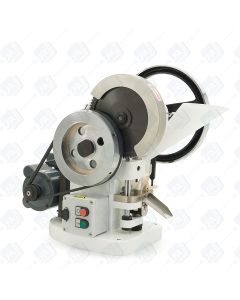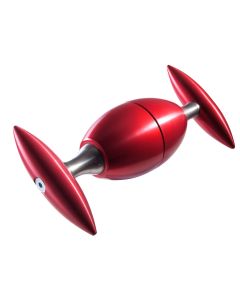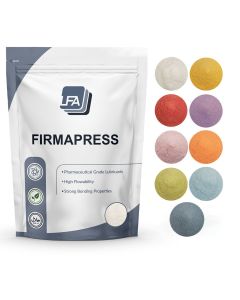Checking Your Tooling
Tooling equipment must be regularly inspected and maintained, a necessary task that is time consuming and expensive for tablet manufacturers. Fortunately there are innovations in machinery and associated technology that are making the job easier, and these include in-process inspections and adjustments. This article is intended to outline some of the more recent developments that may help tablet makers and their businesses.
Inspecting tablet-tooling equipment has several challenges; above all it can be both time consuming and expensive in terms of labour. Burdened by increasing costs of production, some manufacturers cut back on the number of inspections that they carry out or even eliminate them altogether for particular production series, to minimize costs. This can be short-sighted as the quality of the tablets is dependent on the quality of the tooling equipment. Although the equipment might run smoothly for a while, if the tooling exhibits wear, it will affect the quality of the tablet product, and it may only be a matter of time before more serious issues arise. The only way to ensure overall quality of the tablet making process is to inspect the equipment regularly for wear and defects. Keeping of inspection records has been a laborious task in the past and one that is open to abuse with frequent loss of data – sometimes recorded data has been filed away, never to be seen again. Fortunately the efficient collection and storage of information in personal computer databases makes the whole exercise of storing and retrieving data much more streamlined than in the past – allowing the busy tablet manufacturer easily to keep a record of his machinery.
Tooling Inspections
When a tooling manufacturer inspects a tablet making machine, he assesses all aspects of the machinery, ensuring that the equipment performs to specification and conforms to the industry standards. It is not necessary for a tablet manufacturer to go to this length when inspecting his equipment for production or during the production process.
Contrary to some popular misconceptions, it is only necessary for tablet manufacturers to inspect a few essential parts of the machinery, namely the key wear areas. The two most important are those of the working length of the punch and the cup depth, as these two areas of the tablet tooling are the most prone to wear. Both can be measured during in-process inspections. The measurement of other characteristics such as the barrel diameter, overall length and tip dimension of the punches are not crucial as they do not change significantly over the course of a production run, and in any case are impossible to inspect accurately in a working machine.
Abonnez-vous à notre lettre d'information
Punch Working Length Dimension
The working length tolerance of punches applies only when comparing all the punches in a particular tooling set on a machine. The working length of a new punch can be very different to the mean working length of punches in a given tablet machine, and it is wrong to compare the length of new and worn punches. For example a new punch may be designed with 5.230 in. working length with 0.002 in. tolerance range. If the new tool is used in a set, each punch should have a working length of at least 5.299 in. but not more than 5.231 in. By contrast, a set of worn tools can wear to less than 5.229 in. working length so long as they are all within a 0.002 in. range, the set is fine. The key issue is the total tolerance range of 0.002, i.e., each tool must have a working length tolerance of +/- 0.001 in. As an example consider the working lengths of 3 punches of 5.228, 5.227 and 5.226 in. These are all below the lower limit of 5.229in compared with a new tool. The dimensions are however within the acceptable tolerance limit of 0.002 in.
Calculating the working length and the tolerance manually can be time- consuming and difficult for many. Using a computer can make the process faster, accurate and much easier. Even so, it is necessary to enter all of the dimensions of a given set of tools before the punch working lengths can be fully assessed. Once all the punch lengths have been recorded a meaningful statistical analysis can be performed. Don’t try and short-cut this process. It is not recommended, for example, to use the first punch in a set as benchmark against which other punches are compared. The first punch may be significantly more worn than the others, and it is a waste of time to find out later on that the first punch is not at par with the rest of the punches and would require a re-work.
Entering data also presents several problems and one way of overcoming these is to capture the information from the machine directly and process it directly in the computer’s database. The most common way to capture machine data is by hitting a button or pedal connected to one of the USB ports on the computer. Such means of data transfer can eliminate chance of typographical errors, which is quite when reading numbers from a machine and entering the data manually. Some tabletting systems can also communicate and synchronize with other software making it easier to input data without the use of foot data capture pedals or buttons.
Having data stored electronically facilitates the retrieval of information for review or further analysis. Results that have different tolerances can be reviewed, compared with other reports making it easier to check and identify any inconsistencies. The automated approach to data management makes it easier to review data compared to manually viewing printed report. Statistical information such as the average, minimum and maximum working lengths, their standard deviations and range differences can be analysed. Reports from several different inspections on the one machine, or between machines can be compared easily when data acquisition and retrieval is electronic.
Another use for automated electronic data handling systems is during tool matching. Here one can utilize the data already collected to generate reports that are otherwise hard to produce when conducting a manual inspection. If enough data has been collected from different tools, it is possible to match sets of tools in terms of meeting the allowable 0.002 in. tolerance, for example. Finding tools that match closely is important as it allows the tablet manufacturer to lower any deviation of the tablet’s thickness as well as hardness. Both upper and lower punches can be sorted in a database quite easily and in a matter of seconds, tool sets can be located that match perfectly within the allowable tolerance. Manual searching of data would take much longer and in the event perfect matching may not even be possible.
An inventory of the company’s entire tooling equipment can be stored in a single computer database. Such a database can be an excellent source of information, and from it data can be easily shared between tool manufacturers and tablet manufacturer and vice versa. Given the latest technology, it is no longer necessary to perform manual entry of data. Electronically recorded data using laser measuring technology for all tools and their inspections clearly provides the best means for tablet makers to be able to communicate with machinery suppliers in terms of tool wear and performance.
Laser Technology
The advent of laser technology allows inspection of tablet presses without any physical intervention of the inspector. Low cost laser devices can be integrated in the tablet processing machinery allowing for non-contact inspection. The advantage of laser measurements is that because there is no physical contact with the tooling equipment, there is no risk of scratching or marking the punches or dies. Conventional digital callipers and depth gauges can easily scratch the tips of the punches for example. Measuring the cup’s depth using a laser system is as simple as pressing a button that activates the laser. Measurement is automatic and the dimensions are directly transmitted to the computer database. Some laser systems are also powered electronically and as such can reduce labour costs and other operating expenses such as the need for supporting equipment (e.g., compressed air).
Other Ways To Monitor Tools
There are less conventional ways to monitor the wear of tools apart from inspecting the tool itself. One method to do so is to track the number of tablets manufactured with a given set of tools and use historical data for comparison. For example if historical data indicates that the tools have a record of producing 1 million tablets on average; then, if the tool has produced 800,000 tablets, the tool wear could be said to be at 80% of the wear measured for 1 million.
This type of approach is easy with a database that has recorded wear for a given set of tools. The information can also help the manufacturer have a backup of the tools or be warned when a given tool needs to be replaced. Correct forecasting allows tablet manufacturers to contact the tool vendor and request for the needed equipment with plenty of lead time.
Other tool control information obtained from the inspection would also be useful to record in a database. Entering data such as drawings makes it easier to track and maintain tool specifications and provides a visual record for any changes in the care procedures.
Multi-tip Tooling Inspections
Multi-tip tooling is relatively new in the pharmaceutical industry and presents some challenges when it comes to guidelines for inspection. As the equipment has several tips, punches working length as well as overall length need to be recorded in the database, therefore the software to be used must provide differentiation between the information of each punch tip. The ideal method in tool matching for multi-tip punches is to measure the working length for each tip and average the values of the combined working length for the punch assembly. The average of each upper length working length is then matched with the corresponding average length of the lower punch during the tool matching process. Although it is possible to match one tip to another individually, it is time consuming to do so.
Digital Image Technology
The advent of digital photography enables the equipment to be photographed easily during the inspection process. The pictures taken can be uploaded to the database for reference and can be linked to previous records, attached to email and sent to the tool vendor for analysis. An easily searchable database enables other individuals to check and have access to the information provided by the tooling inspector.
Inspection of the Dies
To date, there is no cost effective way to do an inspection of dies. During inspection, the focus is mainly on the wear points on the die, i.e., by measuring the internal diameter of the die bore. Measuring the inner diameter of round shape dies is easy; measuring non- circular objects is not. Characterizing an oblong shaped die bore, for example, would require measurement of the minor and major axes. It is difficult to measure the centre line of both the major and minor axes accurately and failure to measure the axis correctly can lead to errors.
Die wear is quite a common occurrence, especially when compressing hard, abrasive granules and powders. Die wear is also known as “die ringing” because the wear takes place in the area of the die bore where the tablet is compacted. This area where the compression takes place is also known as the ‘wear ring’. In this area, wear appears in the bore as a double ring (see Figure 4) due to the upper and lower punch tips flexing and bending within the clearance between the tips and the die bores during full compaction. The granules react between these surfaces leading to compressive and abrasive wear. When the wear becomes significant, it will lead to problems such as tablet capping or delamination and increased tablet ejection forces. Close inspection of the die bore by the technician (i.e., applying what is generally known as ‘bore sight”) is usually enough to identify this type of wear. A bore gauge or a sensitive deviation indicator may also be useful but visual inspection for cracks, nicks, wear rings or abrasions is usually enough to assess whether or not the die is any longer acceptable for use.
Measuring the Punch Tip Diameter
It is difficult to measure the tip diameter of a worn punch and therefore this is not normally done as part of an in-process inspection. As wear only happens on the edge of the leading tip, conventional contact measure equipment is also ineffective. Using a micrometer to measure a straight (horizontally) tip is often a failure as the wear is usually difficult to see with the naked eye. This is not the case when measuring a new tip, as there is no wear of the tip itself. The tip diameter is a dimension often quoted and used by tooling manufacturers, but not for in-process inspections of tablet manufacturers. If the punch tip diameter needs to be measured, digital and optical comparators are now available that make the job somewhat easier than in the past.
Security Features
To prevent the corruption of data stored on computers, it is important to include security features to protect the database. An electronic audit can be used to record previous data before new data or information is added or deleted. Referring to previous data may help to assess whether there has been modification or alteration of previous data. Backup of data either on separate hard-disks or on cloud-based databases is highly desireable.
Summary
Changes in the inspection process have long been overdue and the tooling industry is now embracing new technology. Machinery inspection, which was once a manual and costly process has now evolved into an activity in which data are collected automatically helping improve the quality of tablets. A database of tooling measurements and recodes makes it easier to provide information, forecast and even provide historical analysis. The automation of many processes allows non-contact inspection, which reduces the risk of damages to sensitive tooling equipment. The use of digital databases and laser measuring technology enables tool manufacturers to produce high quality tablets more efficiently.
The pressure that the industry faces helps promote change. The changes that have occurred in recent years in terms of monitoring, manufacturing and quality control is evidence that the sector realizes the need for the industry to work more efficiently. The success and failure of the approaches depends on the understanding and knowledge of all involved.
Although there continue to be challenges in creating tablets from powders, technology is helping. Understanding the different dynamics of the tablet manufacturing process is important as is developing an understanding of the properties of materials and the tools that are essential elements of tablet making. Technology has enabled tablet makers to quantify and measure the various machine parameters during inspections, and compare these with the tablets produced. The approach is still in some extent empirical; however, it is far more superior than relying on manual methods of data collection and analysis, or trusting solely on in-house experience. Current technology gives the ability to test different methods of manufacture with the use of a single instrument providing ease of access to data. The collected data can be accessed easily and is instantly transferrable allowing many in the industry to study the complexities of the process and develop new ideas and products.





